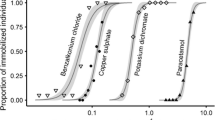Abstract
Two chronic toxicity experiments were conducted with Daphnia magna. In a semi-static experiment with cohorts, the no effect level for bromide in respect of the intrinsic rate of natural increase (derived from age-specific survival and fecundity) was 10 mg l−1. A second test was started with small populations in an intermittent-flow system. These populations had a stable age distribution, were composed of cohorts of different ages, and showed an almost perfect logistic growth. Model calculations showed that bromide reduced the upper numerical limit (carrying capacity). It also increased the time-lag required to attain the maximum reproduction rate. For the first parameter, a no effect level of 14 mg l−1 was calculated. For the latter a threshold could not be detected. The EC50 and EC10 were 27 and 18 mg l−1, respectively. Additional experiments showed that individual growth of D. magna in time could also be described by a logistic equation. The age structure of the populations changed when food became limiting. This was parallelled by a reduction of the mean brood size. In conclusion it is stated that the results of the toxicity studies with populations support Halbach's view (1984), that population dynamics can be used like a ‘magnifying glass’ to detect small sublethal ecotoxicological effects of environmental pollutants.
Similar content being viewed by others
References
APHA (American Public Health Association), American Water Works Association, and Water Pollution Control Federation, 1980. Standard Methods for the examination of water and wastewater, 15th edn. New York, 1134 pp.
Buikema, A. L. Jr., J. G. Geiger & D. R. Lee, 1980. Daphnia toxicity tests. In: A. L. Buikema Jr. & J. Cairns Jr. (eds.), Aquatic Invertebrate Bioassays. American Society for Testing and Materials, Philadelphia: 48–69.
Canton, J. H., P. W. Wester & E. A. M. Mathijssen-Spiekman, 1983. Study on the toxicity of sodium bromide to different freshwater organisms. Fd. Chem. Toxic. 21: 369–378.
Dumont, H. J., I. van de Velde & S. Dumont, 1975. The dry weight estimate of biomass in a selection of Cladocera, Copepoda and Rotifera from the plankton, periphyton and benthos of continental waters. Oecologia (Berl.) 19: 75–97.
Gentile, J. H., S. M. Gentile, N. G. Hairston Jr. & B. K. Sullivan, 1982. The use of life-tables for evaluating the chronic toxicity of pollutants to Mysidopsis bahia. Hydrobiologia 93: 179–187.
Hebert, P. D., 1978. The population biology of Daphnia (Crustacea, Daphnia). Biol. Rev. 53: 387–426.
Halbach, U., M. Siebert, M. Westermayer & C. Wissel, 1983. Population ecology of rotifers as a bioassay tool for ecotoxicological tests in aquatic environments. Ecotoxicol. envir. Safety 7: 484–513.
Halbach, U., 1984. Population dynamics of rotifers and its consequences for ecotoxicology. Hydrobiologia 109: 79–96.
Kersting, K. & C. Van Der Leeuw-Leegwater, 1976. Effect of food concentration on the respiration of Daphnia magna. Hydrobiologia 49: 137–142.
Kooyman, S. A. L. M., A. O. Hanstveit & H. Oldersma, 1983. Parametric analyses of population growth in bio-assays. Water Res. 17: 527–538.
Kooyman, S. A. L. M. & J. A. J. Metz, 1984. On the dynamics of chemically stressed-populations: the deduction of population consequences from effects on individuals, Ecotoxicol. envir. Safety 8: 254–274.
Lotka, A. J., 1913. A natural population norm. J. Wash. Acad. Sci. 3: 241–248, 289–293.
Maki, A. W., 1979. Correlations between Daphnia magna and fathead minnow (Pimephales promelas) chronic toxicity values for several classes of substances. J. Fish. Res. Board Can. 36: 411–421.
Marshall, J. S., 1978. Population dynamics of Daphnia galeata mendotae as modified by chronic cadmium stress. J. Fish. Res. Board Can. 35: 461–469.
Pielou, E. C., 1977. Mathematical Ecology. John Wiley & Sons Inc., New York, 385 pp.
Richman, S., 1958. The transformation of energy by Daphnia pulex. Ecol. Monogr. 28: 273–291.
Roughgarden, J., 1979. Theory of Population Genetics and Evolutionary Ecology: An introduction. MacMillan, New York, 634 pp.
Tessier, A. J. & C. E. Goulden, 1982. Estimating food limitation in cladoceran populations. Limnol. Oceanogr. 27: 707–717.
Van Leeuwen, C. J., W. J. Luttmer & P. S. Griffioen, 1985. The use of cohorts and populations in chronic toxicity studies with Daphnia magna: a cadmium example. Ecotox. envir. Safety 9: 26–39.
Williams, D. A., 1971. A test for differences between treatment means when several dose levels are compared with a zero dose control. Biometrics 27: 103–117.
Williams, D. A., 1972. The comparison of several dose levels with a zero dose control. Biometrics 28: 519–531.
Author information
Authors and Affiliations
Rights and permissions
About this article
Cite this article
van Leeuwen, C.J., Rijkeboer, M. & Niebeek, G. Population dynamics of Daphnia magna as modified by chronic bromide stress. Hydrobiologia 133, 277–285 (1986). https://doi.org/10.1007/BF00005599
Issue Date:
DOI: https://doi.org/10.1007/BF00005599




